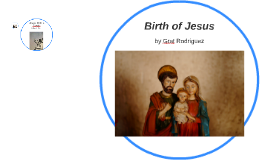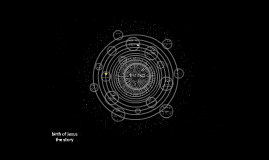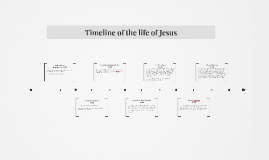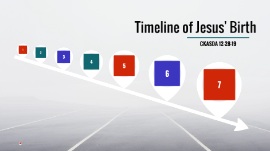Birth of Jesus
Transcript: The Birth of Jesus Christ By: Viviana Zavala Mary's birth story is told in the New Testament of the Bible, while in many religions they believe she is the mother of Jesus, based off the bible. She was engaged to a man named Joseph and was a virgin when she became pregnant with Jesus. In Nazareth of Galilee, an angel named Gabriel, came to Mary to deliver the news that she would be the mother to Jesus, the savior of the world and son of God. Mary of course asked how that came to be possible and the angel replied to her stating the Holy Ghost/Spirit would come upon her all while it being through the power of God. Mary's Pregnancy Mary's Pregnancy Mary is honored as the "Mother of God" in several religions, such as within the Catholic faith (Roman Catholic Church). Others, like Christians, don't praise her due to believing God should be the only figure given that worship. Muslims as well honor her for being a virgin chosen to be the mother of Jesus, seeing she must be special for being given that honor by God. Mary's Praise and Symbolic Importance Mary's Praise and Symbolic Importance Researchers have come to believe that the date of December 25th was decided amongst the Roman Catholic Church for a variety of certain reasons. The main one being that, this particular date ties in with the winter solstice and Saturnalia. The winter solstice, otherwise known as midwinter, occurs when one of the Earth's poles has its maximum tilt away from the Sun. As for the Saturnalia, it is an ancient Roman festival that took place in December celebrating Saturn. This signified the importance of light coming after the solstice. It is believed by some scholars that because these winter celebrations and the Pagan festival, were being celebrated on this date, it gave the church the chance to choose it and benefit in a way where they could co-opt these popular events. How December 25th Came to be When Jesus was Born Some scholars base their belief and knowledge of the time Jesus was born on the biblical story of Herod the Great, therefore estimating the time between 6 B.C. and 4 B.C. Herod, being the ruler of Judea, is believed to have died around 4 B.C. On the other hand, historians either disagree with his day of death or they don't believe he or his background story ever existed. (The story of Herod sending out an order to have all male babies in Bethlehem killed in hopes of murdering baby Jesus.) Scholars vs. Historians' Beliefs on Birth date Scholars vs. Historians' Beliefs on Birth date The Star of Bethlehem supposedly indicated the birth of Jesus, so scholars have tried correlating this with astronomical events. An astronomer during the year of 1991, Colin Humphreys, proposed that this star was a slow-moving comet, which was recorded in 5 B.C. by Chinese observers. Another topic of debate is the birth month of Jesus. A different astronomer, Dave Reneke, proposed in 2008 that Jesus was a summer baby. He reviewed that the coming together of Jupiter and Venus forming a light in the sky may have been the Star of Bethlehem, and with the use of computer models they dated this to have happened on June 17, in 2 B.C. Other researchers claim a similar event like this occurred, except it was between Saturn and Jupiter in the month of October of 7 B.C., meaning Jesus was born in the fall. Astronomical Viewpoint/Research Astronomical Influence Theology is the study of the nature of God and religious belief. Those who are professionals and study this field are considered theologians. They argue that Jesus was born in the season of spring. This is proposed by them due to the biblical story that shepherds were watching over their flocks on the night Jesus was born. This is something that would have occurred not in the winter or fall, but spring. Theologian's Perspective Theologian's Perspective Bethlehem, Jerusalem is considered by many religions (Christians, Catholics, etc.) the place where Mary gave birth to her son Jesus. Those all over the world visit this place, especially the Church of the Nativity, which is known to be the exact spot where Jesus Christ was born. The Church of the Nativity was built over the place in 326, according to Professor Qustandi Shomali, when Emperor Constantine made the decision of making Christianity the Roman Empire's official religion. Constantine's mother built the church, where the original columns dating back to the 4th century still stand. After the declaration of this religion, pilgrims traveled from all different parts to honor and visit the site of Jesus's birth. It is also known that the traditional site of where Jesus was born has been identified since around the middle of the 1st century at least. Within this first century, the Roman emperor Hadrian destroyed the city of Bethlehem and built a temple over the spot where pilgrims would come to visit, being where Jesus was born. This temple preserved the place rather than having it destroyed according to researchers and Shomali. The Door of Humility

















